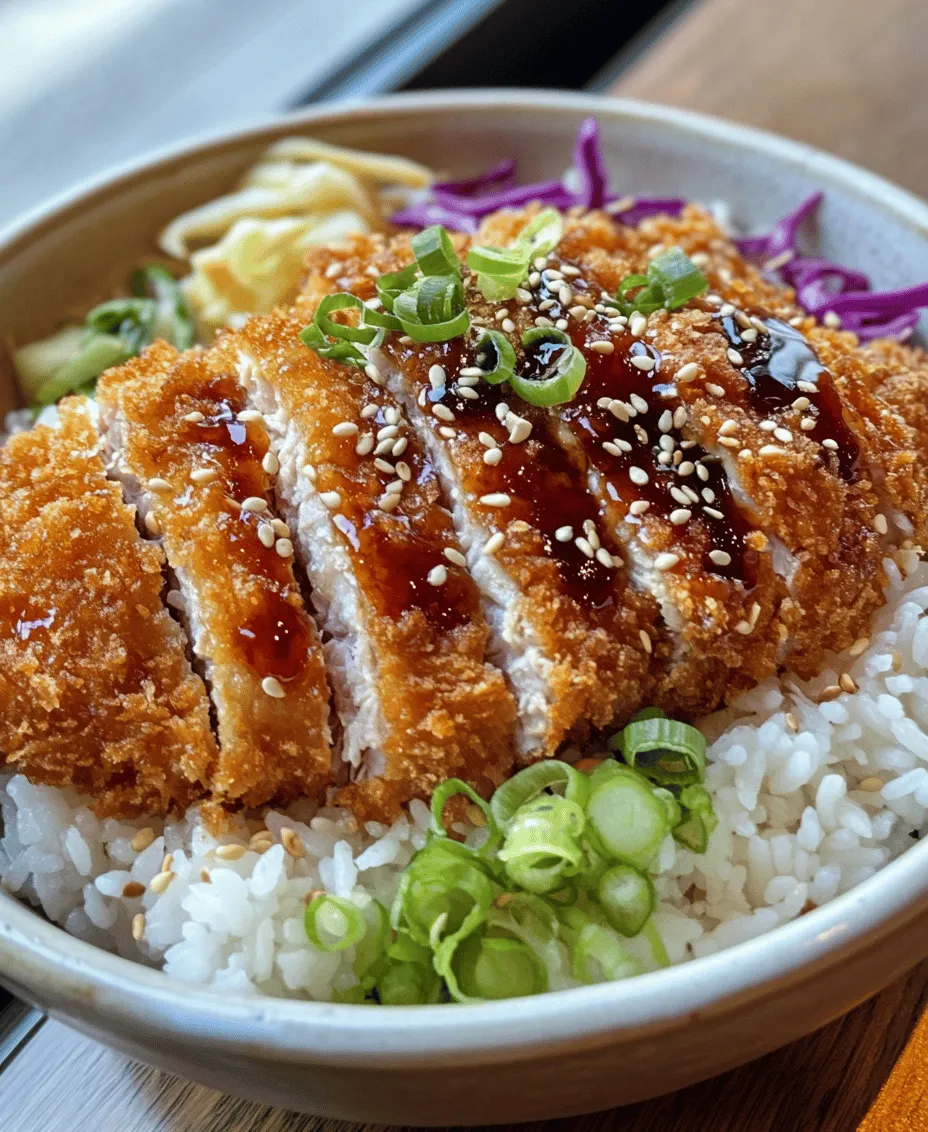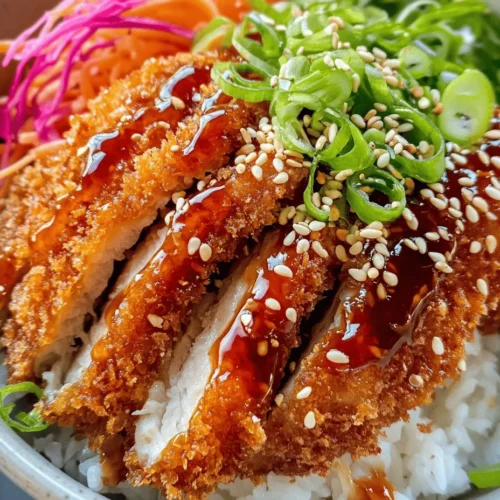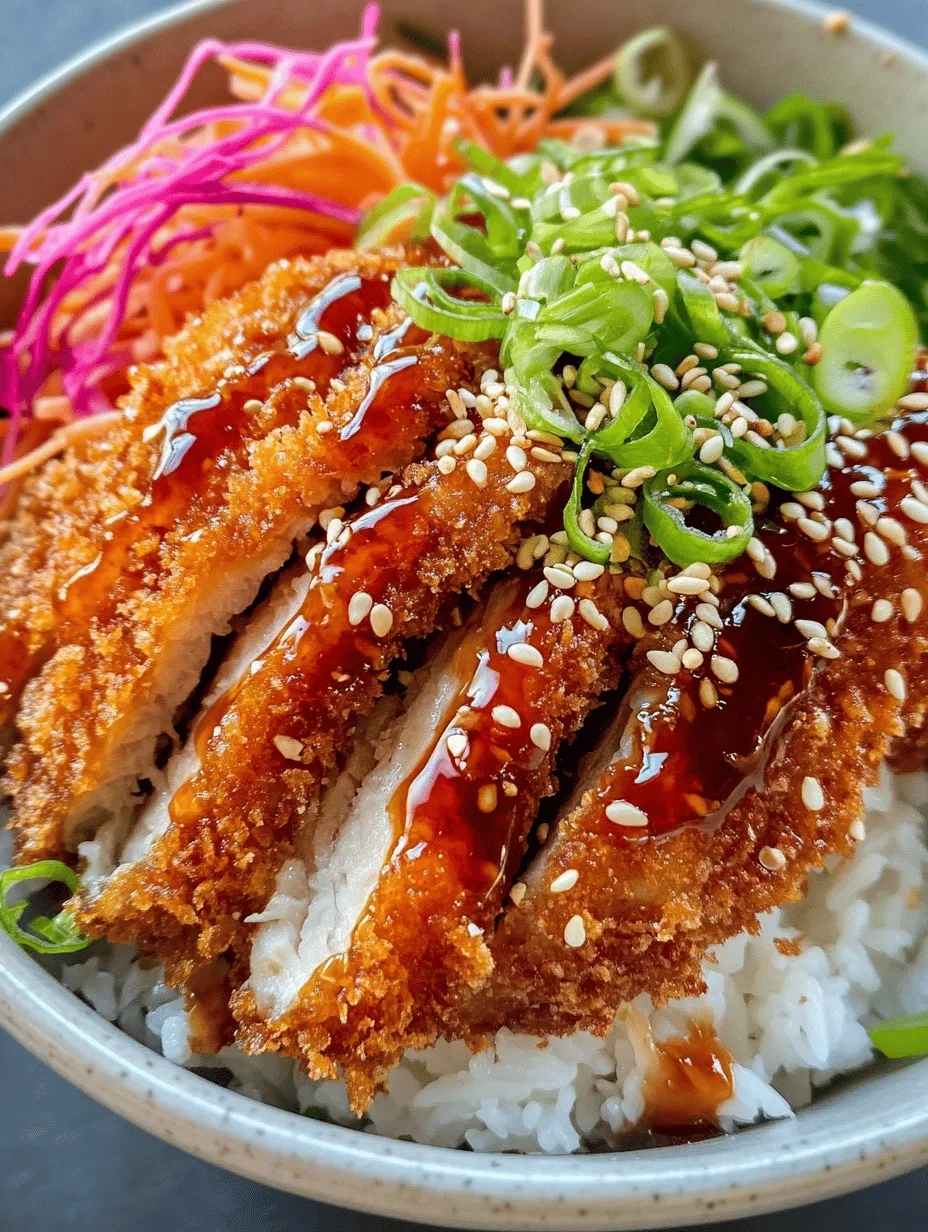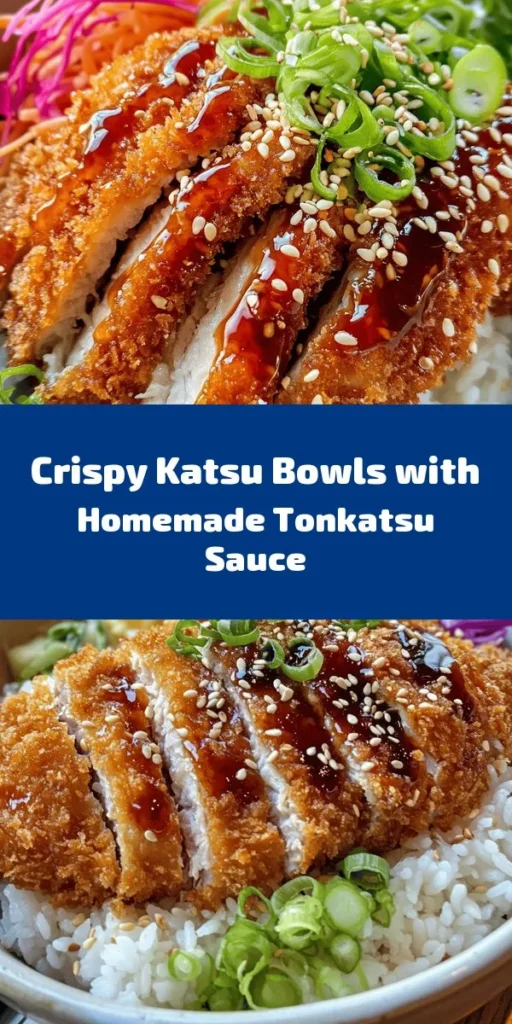Introduction
Katsu bowls have surged in popularity, becoming a staple in both Japanese cuisine and the hearts of food enthusiasts around the globe. Characterized by their delightful combination of crispy fried meat, savory sauce, and fresh toppings, these bowls offer a satisfying meal that can easily be prepared at home. The star of the dish is undoubtedly the crunchy katsu, typically made from succulent pork, which is breaded and fried to golden perfection.
What makes katsu bowls particularly appealing is their versatility and the ease with which they can be customized. Whether you prefer a traditional approach or want to experiment with different toppings and ingredients, katsu bowls can cater to your taste. The combination of textures—the crunch of the katsu, the creaminess of the sauce, and the freshness of the vegetables—creates a harmonious balance that delights the palate.
At the heart of this dish lies the rich and savory Tonkatsu sauce, which elevates the flavor profile of the katsu and adds depth to the entire bowl. Alongside the breaded pork, various toppings such as shredded cabbage, sliced green onions, and pickled vegetables enhance both the taste and presentation. This article will take you through the process of creating your very own Crunchy Katsu Bowls with Savory Tonkatsu Sauce, ensuring that you enjoy every step of this delicious culinary journey.
Understanding Tonkatsu Sauce
Tonkatsu sauce is a quintessential component of katsu dishes in Japan, known for its thick, rich consistency and complex flavor. It serves as the perfect accompaniment to the crispy pork cutlet, enhancing its taste while adding a touch of sweetness and tanginess. This sauce is derived from a blend of ingredients that harmonize beautifully, making it a beloved staple in Japanese cooking.
The base of Tonkatsu sauce is ketchup, which lends a subtle sweetness that complements the savory elements of the dish. Worcestershire sauce adds depth with its complex flavor profile, which includes tangy, sweet, and slightly spicy notes. Soy sauce contributes umami, the savory fifth taste that enhances overall flavor, while mirin—a sweet rice wine—adds a hint of sweetness along with a touch of acidity.
To create a well-rounded sauce, additional ingredients are included to introduce layers of flavor. Brown sugar brings richness and sweetness, while Dijon mustard adds a mild spiciness. Garlic powder and ground ginger enhance the sauce’s complexity, providing aromatic notes that elevate the overall taste.
For those looking to personalize their Tonkatsu sauce, variations abound. You can adjust the sweetness by modifying the amount of sugar or ketchup used, or add hot sauce for a spicy kick. Alternatively, incorporating miso paste can introduce a unique umami depth that pairs exceptionally well with the pork.
Preparing the Perfect Tonkatsu
When it comes to making the perfect katsu, selecting the right cut of meat is crucial. Boneless pork chops are the traditional choice, offering a good balance of flavor and tenderness. They are easy to work with and provide the desired juicy interior when cooked correctly.
Step-by-Step Guide to Seasoning and Breading the Pork
1. Seasoning the Pork: Start by seasoning the pork chops generously with salt and pepper on both sides. This step is essential for enhancing the meat’s flavor, as it helps to draw out moisture and create a tasty crust when cooked.
2. Setting Up the Breading Station: A well-organized breading station is key to achieving a perfect katsu. You will need three shallow dishes for this process:
– The first dish should contain all-purpose flour, which will help the egg adhere to the pork.
– The second dish should hold beaten eggs, which act as a binding agent.
– The third dish should be filled with panko breadcrumbs, known for their light, airy texture that yields a crispy coating when fried.
3. Breading the Pork: Take each seasoned pork chop and coat it in flour, shaking off any excess. Next, dip the chop into the beaten eggs, ensuring it is fully covered. Finally, press the chop into the panko breadcrumbs, firmly adhering the crumbs to create an even coating. This three-step process guarantees that the katsu will achieve that signature crunch once fried.
The Frying Process
The frying method you choose will significantly impact the texture of your katsu. For optimal results, deep frying is recommended, as it allows for even cooking and a consistently crispy exterior. If you don’t have a deep fryer, a heavy skillet can work just as well.
1. Heat the Oil: In a large, deep skillet or frying pan, add enough oil to cover the bottom—about half an inch deep. Heat the oil over medium-high heat until it reaches a temperature of 350°F (175°C). To test if the oil is ready, you can drop a small piece of bread into it; if it sizzles and turns golden brown within a minute, the oil is hot enough.
2. Frying the Katsu: Carefully place the breaded pork chops in the hot oil, making sure not to overcrowd the pan, as this can cause the temperature to drop and result in soggy katsu. Fry each chop for about 3-4 minutes on one side until golden brown, then flip and cook for an additional 2-3 minutes on the other side.
3. Draining Excess Oil: Once cooked, transfer the katsu to a wire rack or a plate lined with paper towels to drain any excess oil. This step is vital for maintaining the crispiness of the pork. Let the katsu rest for a few minutes before slicing it into strips.
With these steps, you can create perfectly crispy katsu that will serve as the foundation for your Crunchy Katsu Bowls. The combination of well-seasoned, breaded pork and the rich, savory Tonkatsu sauce will undoubtedly impress your family and friends, making this dish a favorite in your home. Stay tuned for the next part of the article, where we will explore the assembly of the katsu bowls and additional toppings that will elevate your meal to new heights.

Ideal Oil Temperature and Cooking Time for the Perfect Tonkatsu
To achieve the perfect Tonkatsu, mastering the oil temperature is crucial. Ideally, you should heat your frying oil to 350°F (175°C). This temperature allows the breaded pork cutlet to fry evenly, resulting in a crispy exterior while ensuring the meat remains juicy and tender inside. To check if the oil is at the right temperature, you can drop a small piece of bread into the oil; if it sizzles and browns within about 60 seconds, your oil is ready.
The cooking time for each Tonkatsu cutlet typically ranges from 4 to 6 minutes per side. This timing can vary depending on the thickness of the meat and the oil temperature. To ensure that your Tonkatsu is cooked to perfection, it’s essential to check the internal temperature with a meat thermometer, which should read 145°F (63°C) for safe consumption. By following these guidelines, you can serve perfectly cooked Tonkatsu that is both safe and delicious.
Assembling the Crunchy Katsu Bowls
Assembling your Crunchy Katsu Bowl is where the magic happens. Each component plays a vital role in creating a well-rounded meal that is not only tasty but visually appealing.
Cooked White Rice as the Base
The base of your Katsu Bowl is cooked white rice. Opt for short-grain rice for a stickier texture that clumps well, making it easier to eat with chopsticks. Alternatively, you can use jasmine or basmati rice for a fragrant twist. If you’re looking for a healthier option, consider brown rice or cauliflower rice, which will add fiber and nutrients to your meal.
Shredded Cabbage for Crunch and Freshness
Next is the shredded cabbage, which adds a refreshing crunch and balances the richness of the fried cutlet. The crisp texture of the cabbage complements the tender Tonkatsu perfectly. You can use green cabbage, but feel free to experiment with Napa cabbage or even a mix of purple and green for a colorful presentation.
Sliced Green Onions for Garnish and Flavor
Don’t forget to sprinkle sliced green onions on top. They provide a mild onion flavor and a pop of color that enhances the overall appearance of the bowl. The green onions also contribute a bit of freshness that cuts through the richness of the pork.
Optional Garnishes: Pickled Ginger and Sesame Seeds
For those seeking an extra layer of flavor and visual appeal, consider adding pickled ginger and sesame seeds. Pickled ginger brings a tangy crunch that contrasts beautifully with the savory flavors of the Tonkatsu, while toasted sesame seeds add a nutty aroma and a delightful crunch.
Visual Appeal of the Assembled Bowl
When assembling your bowl, consider the visual appeal. Start with a generous scoop of rice at the bottom, then layer the shredded cabbage atop it. Place the crispy Tonkatsu cutlet on one side and garnish with green onions, pickled ginger, and sesame seeds on the other. This arrangement not only looks appetizing but also invites diners to mix and match flavors and textures in each bite.
Serving Suggestions and Pairings
Crunchy Katsu Bowls are incredibly versatile and can be paired with a variety of side dishes and drinks to enhance your meal.
Ideas for Side Dishes or Drinks
For a refreshing side, consider a simple miso soup or a Japanese salad dressed with sesame vinaigrette. These options complement the savory notes of the Katsu while adding a lightness to the meal. If you’re looking for something heartier, a side of edamame or steamed dumplings could work well.
When it comes to drinks, green tea is a classic pairing that cleanses the palate, but you could also opt for a light beer, such as a Japanese lager, which can enhance the flavors of the dish.
Customizing the Bowl with Additional Toppings
One of the best aspects of Katsu Bowls is their adaptability. Feel free to customize your bowl by adding additional toppings like avocado, which brings creaminess and healthy fats, or kimchi for a spicy kick. Other options include sautéed mushrooms or roasted vegetables, which can add depth and variety to the dish.
Versatility for Different Occasions
Crunchy Katsu Bowls are perfect for various occasions, from a quick weeknight dinner to meal prep for the week ahead. They can also be a hit at gatherings or potlucks, where everyone can assemble their bowls to suit their tastes. The ability to prep components in advance means you can enjoy this delicious meal with minimal effort during busy times.
Nutritional Insights
Understanding the nutritional profile of your Crunchy Katsu Bowl can help you make informed choices while enjoying this delightful dish.
Overview of Nutritional Profile
A standard Katsu Bowl typically offers a good balance of protein, carbohydrates, and fats. The pork cutlet provides a substantial protein source, crucial for muscle repair and overall health. White rice contributes carbohydrates, providing energy, while the frying process introduces some fats into the meal.
Balancing the Dish with Vegetables
To ensure your Katsu Bowl is well-rounded, incorporate a variety of vegetables. The addition of shredded cabbage, green onions, and any extra toppings like avocado or kimchi not only boosts flavor but also adds essential vitamins, minerals, and fiber, making the dish more nutritious.
Tips for Making the Recipe Lighter
If you’re looking to lighten up your Katsu Bowl, consider baking the Tonkatsu instead of deep-frying. Coat the cutlets with breadcrumbs and bake them in the oven at 400°F (200°C) for about 20-25 minutes, flipping halfway through. This method significantly reduces the amount of oil used, making for a healthier version of this beloved dish while still delivering on taste.
Conclusion
Crunchy Katsu Bowls with Savory Tonkatsu Sauce are a delightful and versatile meal that brings together crispy pork, fluffy rice, and a medley of fresh toppings. The combination of flavors and textures creates an experience that is not only satisfying but also customizable to fit any occasion.
As you experiment with this recipe, don’t hesitate to make it your own. Whether you stick to the traditional components or venture into new toppings and flavors, the possibilities are endless. The cultural significance of Katsu in Japanese cuisine speaks to its rich history and growing popularity around the world, making it a dish that resonates with many.
Enjoy the process of crafting your Katsu Bowls and exploring the myriad ways to present this classic dish. With each bite, you’ll not only taste the delicious flavors but also appreciate the art of Japanese cooking that has captured hearts globally. Bon appétit!



